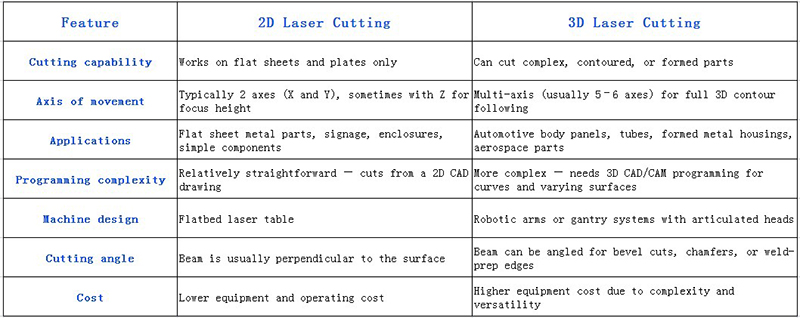The difference between 2D laser cutting and 3D laser cutting
2D laser cutting is a manufacturing process where a laser beam is used to cut flat sheet materials along a two-dimensional path.
How It Works
Material (metal, plastic, wood, composites, etc.) is placed on a flat cutting bed.
A high-powered laser beam (CO₂, fiber, or Nd\:YAG) is directed onto the surface.
The cutting head moves in X and Y directions (two axes) according to the design file (CAD/DXF).
The laser melts, burns, or vaporizes material along the programmed path.
Key Features
Works only on flat materials (no depth contouring).
High precision — tolerances often ±0.1 mm or better.
Can cut intricate patterns, holes, and edges.
Often used with nesting software to minimize material waste.
Can also engrave or etch designs without full cutting.
Common Materials
Mild steel, stainless steel, aluminum
Acrylic, polycarbonate, wood
Thin composites
Advantages
High accuracy for flat parts
Fast production for sheet-based manufacturing
Minimal post-processing
Little or no tool wear (non-contact process)
Limitations
Cannot cut formed or 3D-shaped parts
Limited to thicknesses supported by the laser’s power (e.g., 20–25 mm for steel on high-power machines)
Edge quality may vary with thickness and material type
Example Applications
Sheet metal brackets
Decorative panels and signage
Gaskets
Machine covers and housings
3D laser cutting is a manufacturing process that uses a high-powered laser to cut or trim complex shapes on three-dimensional parts instead of just flat sheets.
How It Works
A multi-axis laser head (often 5-axis or more) moves in X, Y, Z directions and can tilt/rotate to follow curves.
The laser can also be mounted on a robotic arm or paired with a rotating/tilting work table.
The system follows the part’s 3D geometry using a CAD/CAM program, ensuring the cut stays precise even on angled or curved surfaces.
Advantages
Cutting complex shapes:Works on irregular, bent, or formed surfaces.
High precision: Maintains tight tolerances even with intricate contours.
No physical contact:No tool wear; suitable for delicate or thin-walled parts.
Flexibility: Can cut, trim, or drill holes after forming — no need to redesign the part for flat cutting.
Common Applications
Automotive: Trimming car body panels, cutting holes in bumpers, dashboards, or formed sheet metal.
Aerospace: Cutting formed panels, turbine parts, or complex ducts.
Tubes & Pipes: Creating angled cuts, slots, or holes along curved surfaces.
Appliances & Machinery: Modifying pre-formed metal or plastic components.
Typical Machine Types
5-axis CNC laser cutters: Fixed laser source with moving table/head.
Robotic arm laser systems: Laser mounted on a robot for extreme flexibility.
Tube and profile laser cutters: Specialized for round, square, or irregular profiles.
In short:
2D laser cutting stops at flat parts.
3D laser cutting follows the part’s curves — think of it as “laser sculpting” instead of “laser drawing.”
Here’s the key difference between 2D laser cutting and 3D laser cutting, broken down clearly:
1. Cutting Capability & Geometry
2D Laser Cutting
Works on flat sheet materials (metal sheets, plastics, wood, etc.).
Cutting is done in the X and Y axes only.
Can produce flat profiles, holes, and shapes but no contouring along a 3D surface.
Think of it like drawing with a pen on paper — all movement is flat.
3D Laser Cutting
Can cut complex shapes on 3D surfaces (pipes, formed metal parts, car body panels, etc.).
Cutting head moves along X, Y, Z axes and can tilt/rotate to follow curves and angles.
Enables cutting at angles, bevels, and irregular geometries.
Think of it like sculpting — the tool follows the surface in all directions.
2. Equipment Design
2D: Usually a flatbed laser machine with a stationary cutting bed and a gantry system for the laser head.
3D: Often a robotic arm or multi-axis system that can manipulate both the cutting head and/or the workpiece in multiple directions.
3. Typical Applications
2D Laser Cutting:
Sheet metal fabrication
Sign making
Simple enclosures and brackets
3D Laser Cutting:
Automotive parts (e.g., trimming car panels, cutting holes in formed parts)
Aerospace components
Complex tubing and formed metal work
4. Cost & Complexity
2D: Lower cost, faster for flat parts, simpler programming.
3D: More expensive machines, more complex programming (often with CAD/CAM integration), but can handle advanced manufacturing needs.
Quick Analogy
If 2D laser cutting is like cutting cookies from rolled-out dough with a cookie cutter,
then 3D laser cutting is like carving details on a fully baked cake that has hills, slopes, and edges.


